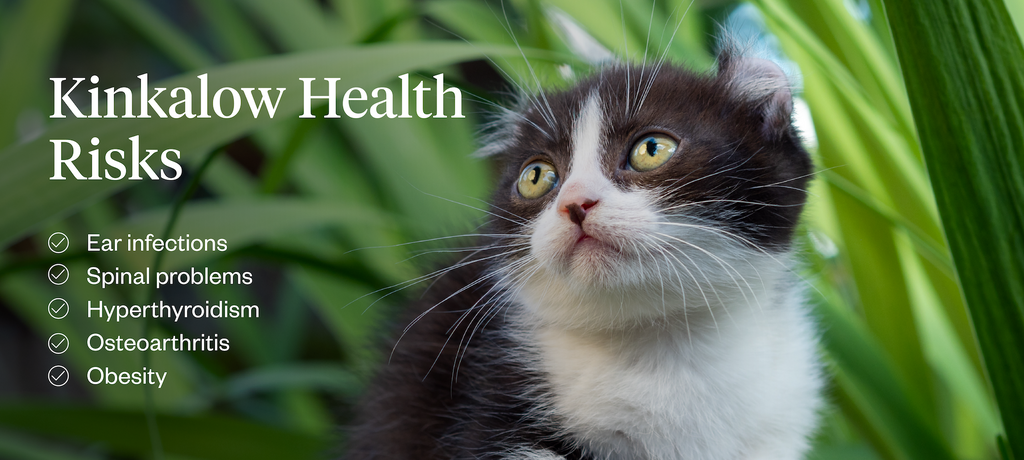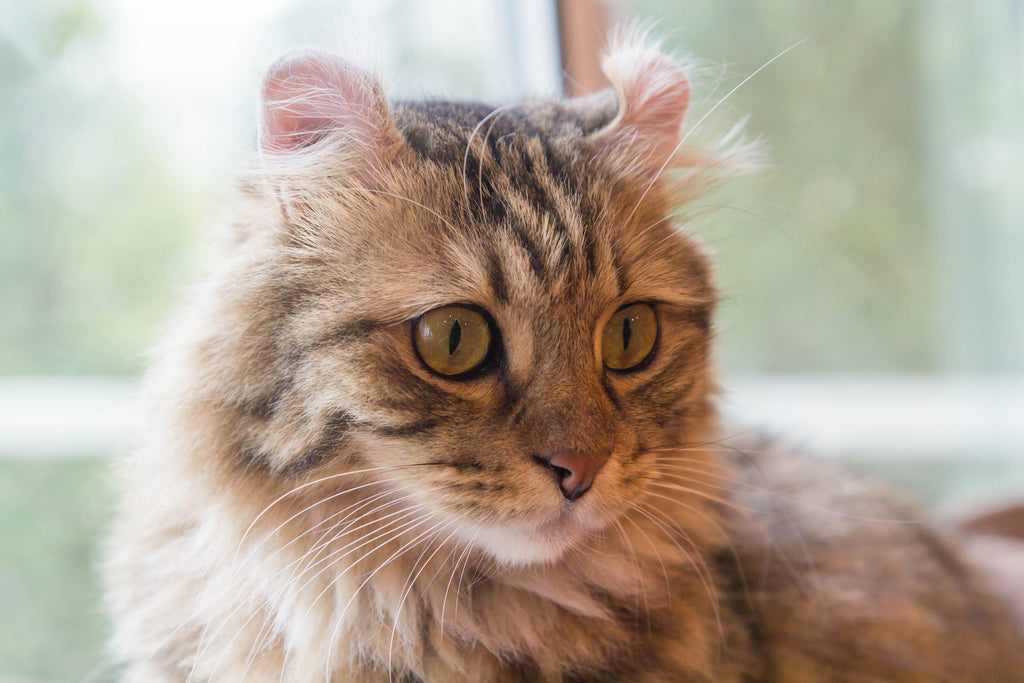8 Min Read
Kinkalow: Pet Profile
Key takeaway
Kinkalows are a fairly new breed of cat, but they’ve already captured the hearts of many. A result of out-crossing breeding, these lovely felines combine the signature ear shape of the American Curl with the adorable short stature of Munchkin cats.

Why pet owners are switching to online vet care with Dutch
-
Prescriptions delivered free to you
-
Fast access to Licensed Vets over video
-
Unlimited video visits and follow-ups
Let’s dive into the fascinating world of Kinkalow cats. These adorable miniature felines boast a distinctive charm. Join us as we explore their history, unique characteristics, essential care tips, and more in this comprehensive blog post.
- History & Origin Of Kinkalow Cats
- Physical Attributes Of Kinkalows
- Behavioral Characteristics Of Kinkalows
- Kinkalow Breed Health Risks
- Caring For A Kinkalow Cat
- Kinkalow Cats: FAQs
- Final Notes
History & Origin Of Kinkalow Cats
The Kinkalow Cat is a fairly new breed. In fact, it first made its appearance in the mid 1990s when the breed was developed by Terri Harris, a US breeder who discovered this breed by crossing an American Curl with a Munchkin. The Kinkalow is so unique that it is considered a rare and exotic breed. The Dwarf Cat Association (TDCA) has recognized the breed, and it has received Experimental Breed Status by the International Cat Association (TICA). Kinkalows are also currently recognized by The Designer Cat Association (TDCA) due to their unique genetic makeup.1
The Kinkalow breed originated through out-crossing breeding, involving unrelated cats to create a unique hybrid. This approach contrasts with line breeding, which uses genetically related cats. These charming felines typically enjoy a healthy lifespan of 12 to 15 years.1
Physical Attributes Of Kinkalows

As previously mentioned, the most distinctive physical traits of Kinkalow cats are undoubtedly their short legs and curled ears. These features are a direct result of their unique parentage, stemming from the American Curl and Munchkin breeds.
Thanks to their Munchkin lineage, Kinkalows have a compact, low-to-the-ground stature, akin to a feline version of the Dachshund. The ideal example of this breed will have legs that when measured from the base of the tail to the point of the shoulder will be 40 to 50% greater than its height.2 Generally, the Kinkalow is a small, compact cat, measuring from between seven and eight inches tall and weighing between five and nine pounds. In fact, they are considered a dwarf feline breed. Their small size and short legs gives them the appearance of being a kitten forever!2
Kinkalow cats exhibit another distinctive feature derived from their American Curl lineage: their curled ears. These curled ears not only contribute to their endearing kitten-like appearance but also resemble the head of a miniature tiger. It's important to note that Kinkalow kittens will usually have straight ears at birth, similar to other breeds.
However, their ears will slowly curl as they grow. Ideally, this curl will not be a dramatic one. Instead, it will be a slight indication of curl. The tips alone should be curled, while maintaining flexibility and also being rounded. In terms of breed specifics, the ear should not curl more severely than a 90 degree arc. The broad base of the ear will actually create a more flared and upright ear, with the ear tips curving towards one another.2
Unlike other types of felines that have a specific color, pattern or fur length, the Kinkalow can feature virtually any pattern or color. Common colors and patterns though include black, cream, orange, gray, tabby, tortie, calico, or even white or chocolate colored.2
Behavioral Characteristics Of Kinkalows
It's crucial to keep in mind that while a breed may have typical behavioral traits, each cat is unique. Therefore, any one Kinkalow might behave slightly differently than another.
In general, most Kinkalows will have a lively, fun personality. They will most times enjoy cuddling but also are active enough to enjoy running from room to room. They are most recognized for their playful personalities along with their natural intellect and curiosity.
Kinkalows are usually eager to please and generally gregarious. Therefore, they tend to want to engage with what their humans are doing. They feature a great personality and attitude for a wide range of family sizes, meaning they work well for elderly owners, singles, or even families with children. They are usually well-behaved if given the affection, attention, and space they desire. They also typically get along with other animals well and are pretty social beings.
Kinkalow Breed Health Risks

The most common health concerns for Kinkalows include cat ear infections, often stemming from the distinctive curled ears of the breed. These infections can result from moisture buildup within the ear canal due to the ear's unique shape. To prevent such issues, regular ear cleaning using an appropriate cleaner and cotton ball is advisable. Remember to always do so with guidance from your vet.
Moreover, because of their Munchkin lineage, Kinkalows might have some health predispositions in common with their Munchkin relatives. For example:
- Osteoarthritis: This condition can lead to joint problems, particularly in Kinkalows with their shorter legs. Regular check-ups and a balanced diet can help manage this concern.
- Hyperthyroidism: An overactive thyroid gland can affect older cats, and it's important to monitor thyroid levels as Kinkalows age.
- Uremia: Kidney-related issues can be more common in certain breeds, so kidney health should be closely monitored, especially as cats age.
- Pectus excavatum: This is a chest deformity that may affect some Kinkalows. It's essential to discuss any potential issues with a veterinarian.1
Understanding these potential health concerns can help prospective owners anticipate and budget for the costs of pet ownership before embarking on the adoption process. Regular veterinary check-ups and a well-balanced diet can go a long way in ensuring the health and longevity of your Kinkalow cat.
Caring For A Kinkalow Cat
Taking good care of your Kinkalow significantly enhances their well-being. Fortunately, establishing a care routine for this breed is simple, allowing owners to nurture a happy and healthy feline family member with ease.
- Diet & nutrition: Diet and nutrition will go a long way in keeping a Kinkalow happy, healthy and provide the foundation for a long life. Cats are obligate carnivores, which should always be kept in mind when choosing their food. In most cases, it’s helpful to choose canned food as this also helps with a cat’s daily water needs. This breed, along with cats in general, thrives under moderate fat, high protein diets with the addition of specific vitamins, amino acids, fatty acids, and minerals. Ideally, it’s best to find a AAFCO approved commercial food or create a homemade food with the help of the cat’s vet. Keep in mind, with their short stature and legs, there could be some accommodation required for cats to access their water bowls, food, and litter box.
- Grooming: When it comes to the grooming needs of a Kinkalow, they are pretty similar to any other cat breed. Owners need to brush their fur, as well as provide eye care, ear care, dental and paw care. Since a Kinkalow’s coat can be either short, long, smooth, shiny, plush, or sleek, it’s difficult to outline exactly how often they need to be groomed. Generally, though, this breed most benefits from weekly brushings, and it’s a good idea to do all the grooming at this time to get into the habit of regular grooming sessions.
- Exercise & enrichment: Owners should aim to play with their Kinkalow between 20 and 60 minutes daily. One way to help enrich this breed and ensure they are intellectually stimulated and engaged is through lick mats, cat toys, scratch mats, and catios, along with supervised outdoor time.
- Preventative care & veterinary check-ups: An ounce of prevention is worth a pound of cure when it comes to preventative treatments such as parasite prevention. It’s also important to get a Kinkalow established at a vet by having non-emergency visits to ensure the cat is in good health and everything is as it should be presently. Issues like grooming, nutrition and getting on a preventative medication like Revolution Plus or Bravecto can be addressed during these visits.
Kinkalow Cats: FAQs
Are Kinkalow cats a recognized breed?
Yes and no. The Kinkalow breed is not currently recognized by all the major cat breed registries. However, it has been recognized by some breed-specific organizations and clubs, like The Dwarf Cat Association (TDCA), The International Cat Association (TICA), and The Designer Cat Association (TDCA).
Can Kinkalow cats jump and play like cats with regular-length legs?
Even with their short legs and overall diminutive stature, Kinkalows are able to jump and play much like any other breed of cat. In addition, they are agile and can engage in most all typical cat activities. Of course, due to their height, their jumping height might be a bit limited.
Can Kinkalow cats have health issues related to their curled ears?
Yes, due to their curled ears which are a notable trait of this breed they can have some health issues related to ear infections. Thankfully, responsible breeding practices are often able to minimize these. In addition, if an owner monitors the ears well and performs regular cleanings as part of an overall grooming routine, a Kinkalow is less likely to have problems, as in many cases, ear infections can often be prevented.

Final Notes
Overall, the Kinkalow is a delightful and affectionate breed, known for its playful nature and love for cuddling. They easily bond with both people and other animals, making them an excellent fit for various family dynamics. However, considering their susceptibility to certain health issues, it's crucial to establish a relationship with a reliable veterinarian from the outset to proactively address any potential health-related concerns.
One easy way to do this is to try Dutch, an accessible and affordable telemedicine service for pets. Dutch offers pet owners quick and easy access to licensed veterinarians, ensuring you get all the necessary guidance for properly raising a Kinkalow right from the start.
Share



